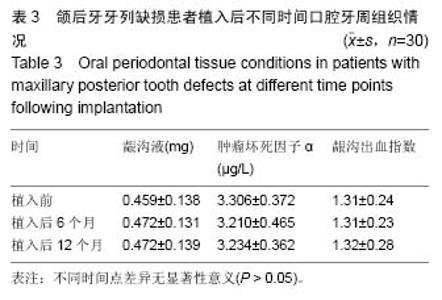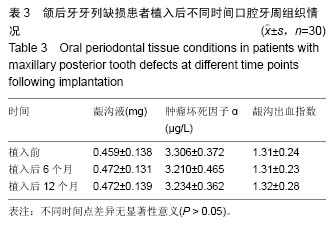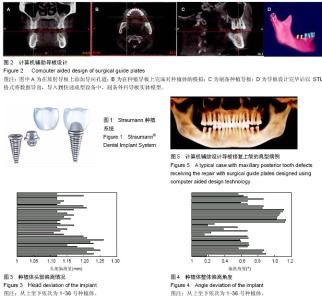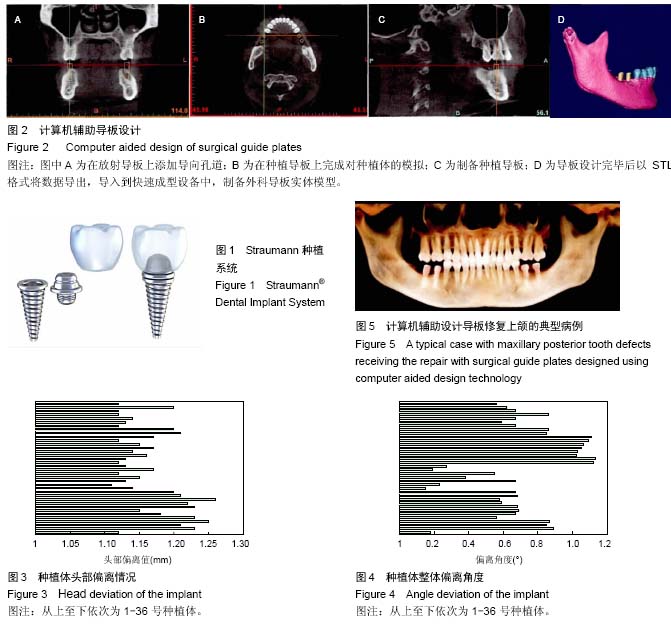Chinese Journal of Tissue Engineering Research ›› 2016, Vol. 20 ›› Issue (20): 2933-2939.doi: 10.3969/j.issn.2095-4344.2016.20.007
Previous Articles Next Articles
Implantation accuracy is not affected by head and angle deviation following computer aided design guide for repair of maxillary posterior tooth defects
Yuan Zhi1, Chen Yi-hui2
- 1First People’s Hospital of Yunnan Province, Kunming 650031, Yunnan Province, China; 2First Affiliated Hospital of Kunming Medical University, Kunming 650032, Yunnan Province, China
-
Received:2016-03-27Online:2016-05-13Published:2016-05-13 -
About author:Yuan Zhi, Attending physician, First People’s Hospital of Yunnan Province, Kunming 650031, Yunnan Province, China -
Supported by:the Natural Science Foundation of Yunnan Province, No. 2009CD087
CLC Number:
Cite this article
Yuan Zhi1, Chen Yi-hui2. Implantation accuracy is not affected by head and angle deviation following computer aided design guide for repair of maxillary posterior tooth defects[J]. Chinese Journal of Tissue Engineering Research, 2016, 20(20): 2933-2939.
share this article
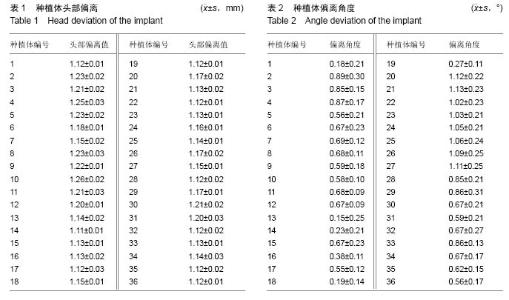
2.1 参与者数量分析及随访情况 术后随访12个月,入组的30例患者均顺利完成随访,随访率为100%,并全部进行进入最终的结果分析。30例一共涉及36个CAD/CAM外科导板,经患者戴入口腔之后均获得稳定的固位效果。一共36枚种植体,均在外科导板辅助下顺利完成准确的,植入过程未出现任何问题。 2.2 种植体头部偏离值 以STL格式对模型进行导出,并导入到植入前数据中进行配准,分析实际种植位置与虚拟位置的偏差情况。经检测植入后对种植体头部最大偏离值为(1.26±0.02) mm,平均偏值为(1.13±0.01) mm(表1,图3)。表明种植体的虚拟植入位置和实际植入位置之间存在的头部偏离情况极小,不会对临床种植体植入精度产生影响。"
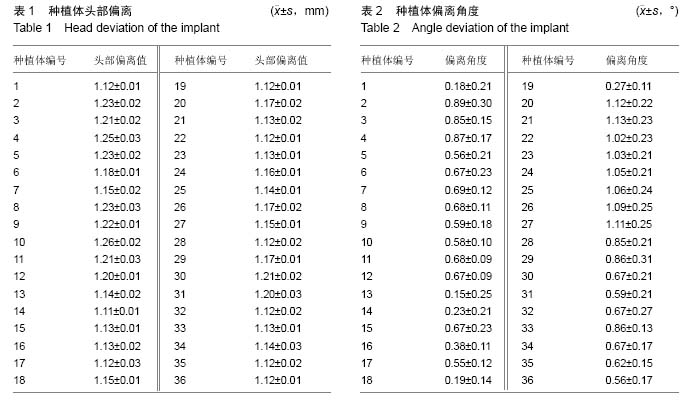
| [1] 马红梅,李斯文,李施施,等.应用椅旁即刻全瓷修复牙体大面积缺损的临床研究[J].中国医科大学学报,2015(10): 883-887.[2] 黄晋杰,谭建国,栾庆先.计算机图像处理技术在前牙美学修复中的应用[J].中华口腔医学杂志,2007,42(7): 387-390.[3] 陈润,杨舟,吴千驹,等.对正常(牙合)者上颌前牙相互间牙冠宽度比例的计算机图像测量分析[J].福建医科大学学报,2012,46(1):39-42.[4] 陈兵.上颌斜面导板在增强支抗和调整咬合中的应用[J].广东牙病防治,2008,16(12):543-544.[5] Yamanishi Y, Yamaguchi S, Imazato S, et al. Influences of implant neck design and implant-abutment joint type on peri-implant bone stress and abutment micromovement: three-dimensional finite element analysis. Dent Mater. 2012;28(11):1126-1133.[6] 陈金林,刘正彤,朱斌,等.改良固定斜面导板矫治安氏Ⅱ类畸形伴后牙锁(牙合)的临床研究[J].口腔医学, 2011, 31(2): 77-79.[7] 郑定国,陈永辉,林培.上颌后牙区种植的临床研究[J].川北医学院学报,2014,(5):485-488.[8] 蔡俊强.两段式宽体种植体修复上颌后牙区缺牙的临床研究[J].中国医药指南,2010,8(29):265-266.[9] Grossmann Y, Pasciuta M, Finger IM. A novel technique using a coded healing abutment for the fabrication of a CAD/CAM titanium abutment for an implant-supported restoration. J Prosthet Dent. 2006; 95(3):258-261.[10] 徐春华.摇椅弓结合上颌前牙平面导板在打开咬合中的临床应用[J].安徽医药,2012,16(11):1625-1626.[11] 王丽萍,张树标,范长斌.倾斜种植体联冠桥修复上颌后牙游离缺失伴骨量不足的临床研究[J].广东牙病防治, 2010, 18(4): 183-186.[12] 王学侠,汤庆奋,刘军,等.改良上颌平面导板辅助打开咬合[J].华西口腔医学杂志,2000,18(3):201-202.[13] 华先明,夏大宏,韩光丽,等.后牙双斜面导板矫治器和面弓治疗孪生兄弟Ⅲ类骨性错(牙合)的疗效对比[J].中华口腔正畸学杂志,2012,19(4):215-222.[14] 刘根娣,李斌,牟永斌.改良平面导板治疗青少年磨牙症伴深覆(牙合)的临床观察[J].口腔医学,2005,25(4): 224-225.[15] 陈兵.上颌平面导板(或斜面导板)对正畸治疗中牙根吸收的影响[J].当代医学,2009,15(24):80-81.[16] 陈霞云.1.CAD/CAM模板在下颌升支垂直截骨术和不翻瓣种植中应用;2.下颌后牙三单位种植体即刻负载的三维有限元分析[D].广州:中山大学,2010.[17] Lee CY, Ganz SD, Wong N, et al. Use of cone beam computed tomography and a laser intraoral scanner in virtual dental implant surgery: part 1. Implant Dent. 2012;21(4):265-271.[18] Carnaggio TV, Conrad R, Engelmeier RL, et al. Retention of CAD/CAM all-ceramic crowns on prefabricated implant abutments: an in vitro comparative study of luting agents and abutment surface area. J Prosthodont. 2012;21(7):523-528.[19] 陈锴.不同生长期平面导板对下切牙牙根吸收影响的比较研究[D].泸州:泸州医学院,2010.[20] Tselios N, Parel SM, Jones JD. Immediate placement and immediate provisional abutment modeling in anterior single-tooth implant restorations using a CAD/CAM application: a clinical report. J Prosthet Dent. 2006; 95(3):181-185.[21] Pan MC, Zhuang HB, Chen CS, et al. A noncontact resonance frequency detection technique for the assessment of the interfacial bone defect around a dental implant. Med Eng Phys. 2013;35(12): 1825-1830.[22] Figliuzzi M, Mangano F, Mangano C. A novel root analogue dental implant using CT scan and CAD/CAM: selective laser melting technology. Int J Oral Maxillofac Surg. 2012;41(7):858-862.[23] 王险峰,黄建生,赵建江,等.上颌后牙区骨量不足经牙槽嵴顶偏腭侧单牙倾斜种植的临床研究-种临床技术的创新[J].实用医学杂志,2012,28(10):1687-1689.[24] 黄娜,李平,李安,等.超短种植体在上颌后牙区骨量严重不足中的应用[J].中国组织工程研究,2015,19(30): 4810-4814.[25] 童庆春,张兴文.长短种植体修复上颌后牙缺失患者的满意度调查分析[J].口腔颌面外科杂志,2014,24(5): 370-373.[26] Wang C, Li Q, McClean C, et al. Numerical simulation of dental bone remodeling induced by implant-supported fixed partial denture with or without cantilever extension. Int J Numer Method Biomed Eng. 2013;29(10):1134-1147.[27] 桂芳,梁立山.上颌窦开窗植骨种植修复术治疗上颌后牙区牙列缺损的远期疗效评价[J].医学临床研究, 2013, 30(4): 801-802.[28] Takaba M, Tanaka S, Ishiura Y, et al. Implant- supported fixed dental prostheses with CAD/CAM-fabricated porcelain crown and zirconia-based framework. J Prosthodont. 2013;22(5): 402-407.[29] Amorfini L, Storelli S, Romeo E. Rehabilitation of a dentate mandible requiring a full arch rehabilitation. Immediate loading of a fixed complete denture on 8 implants placed with a bone-supported surgical computer-planned guide: a case report. J Oral Implantol. 2011;37 Spec No:106-113.[30] Protopapadaki M, Monaco EA Jr, Kim HI, et al. Comparison of fracture resistance of pressable metal ceramic custom implant abutment with a commercially fabricated CAD/CAM zirconia implant abutment. J Prosthet Dent. 2013;110(5):389-396.[31] 松浦正朗.在牙周病病例和非牙周病病例中应用计算机辅助设计导板系统进行上颌窦底提升手术[J].中国口腔种植学杂志,2010,15(3):104-105.[32] Jamshidinia M, Wang L, Tong W, et al. The bio-compatible dental implant designed by using non-stochastic porosity produced by Electron Beam Melting® (EBM). J Mater Process Technol. 2014; 214(8):1728-1739.[33] Lee YH, Bhattarai G, Park IS, et al. Bone regeneration around N-acetyl cysteine-loaded nanotube titanium dental implant in rat mandible. Biomaterials. 2013; 34(38): 10199-10208.[34] Vanegas-Acosta JC, Garzón-Alvarado DA, Lancellotti V. Numerical investigation into blood clotting at the bone-dental implant interface in the presence of an electrical stimulus. Comput Biol Med. 2013;43(12): 2079-2088.[35] 张卉卉,黄志,杨小东,等.定制基台用于上颌后牙区倾斜种植体修复的临床研究[J].中国口腔种植学杂志,2013(1): 18-21.[36] Katsoulis J, Mericske-Stern R, Rotkina L, et al. Precision of fit of implant-supported screw-retained 10-unit computer-aided-designed and computer-aided- manufactured frameworks made from zirconium dioxide and titanium: an in vitro study. Clin Oral Implants Res. 2014;25(2):165-174.[37] 童庆春,张兴文.上颌后牙区骨量不足应用短种植体的临床疗效观察[J].中国口腔颌面外科杂志,2014,12(3): 253-256.[38] 蒋析,林野,胡秀莲,等.下颌后牙游离缺失伴重度垂直骨量不足的计算机辅助种植修复[J].北京大学学报(医学版), 2014,46(2):294-298.[39] Katsoulis J, Mericske-Stern R, Yates DM, et al. In vitro precision of fit of computer-aided design and computer-aided manufacturing titanium and zirconium dioxide bars. Dent Mater. 2013;29(9):945-953. [40] Katsoulis J, Mericske-Stern R, Enkling N, et al. In vitro precision of fit of computer-aided designed and computer-aided manufactured titanium screw-retained fixed dental prostheses before and after ceramic veneering. Clin Oral Implants Res. 2015;26(1):44-49. [41] Katsoulis J, Müller P, Mericske-Stern R, et al. CAD/CAM fabrication accuracy of long- vs. short-span implant-supported FDPs. Clin Oral Implants Res. 2015; 26(3):245-249. [42] de França DG, Morais MH, das Neves FD, et al. Influence of CAD/CAM on the fit accuracy of implant-supported zirconia and cobalt-chromium fixed dental prostheses. J Prosthet Dent. 2015;113(1):22-28. [43] Karl M, Taylor TD. Effect of material selection on the passivity of fit of implant-supported restorations created with computer-aided design/computer -assisted manufacture. Int J Oral Maxillofac Implants. 2011;26(4):739-745. [44] Drago C, Saldarriaga RL, Domagala D, et al. Volumetric determination of the amount of misfit in CAD/CAM and cast implant frameworks: a multicenter laboratory study. Int J Oral Maxillofac Implants. 2010; 25(5):920-929. [45] Dittmer MP, Nensa M, Stiesch M, et al. Load-bearing capacity of screw-retained CAD/CAM-produced titanium implant frameworks (I-Bridge®2) before and after cyclic mechanical loading. J Appl Oral Sci. 2013; 21(4):307-313. |
| [1] | Zhang Tongtong, Wang Zhonghua, Wen Jie, Song Yuxin, Liu Lin. Application of three-dimensional printing model in surgical resection and reconstruction of cervical tumor [J]. Chinese Journal of Tissue Engineering Research, 2021, 25(9): 1335-1339. |
| [2] | Zeng Yanhua, Hao Yanlei. In vitro culture and purification of Schwann cells: a systematic review [J]. Chinese Journal of Tissue Engineering Research, 2021, 25(7): 1135-1141. |
| [3] | Xu Dongzi, Zhang Ting, Ouyang Zhaolian. The global competitive situation of cardiac tissue engineering based on patent analysis [J]. Chinese Journal of Tissue Engineering Research, 2021, 25(5): 807-812. |
| [4] | Wu Zijian, Hu Zhaoduan, Xie Youqiong, Wang Feng, Li Jia, Li Bocun, Cai Guowei, Peng Rui. Three-dimensional printing technology and bone tissue engineering research: literature metrology and visual analysis of research hotspots [J]. Chinese Journal of Tissue Engineering Research, 2021, 25(4): 564-569. |
| [5] | Chang Wenliao, Zhao Jie, Sun Xiaoliang, Wang Kun, Wu Guofeng, Zhou Jian, Li Shuxiang, Sun Han. Material selection, theoretical design and biomimetic function of artificial periosteum [J]. Chinese Journal of Tissue Engineering Research, 2021, 25(4): 600-606. |
| [6] | Liu Fei, Cui Yutao, Liu He. Advantages and problems of local antibiotic delivery system in the treatment of osteomyelitis [J]. Chinese Journal of Tissue Engineering Research, 2021, 25(4): 614-620. |
| [7] | Li Xiaozhuang, Duan Hao, Wang Weizhou, Tang Zhihong, Wang Yanghao, He Fei. Application of bone tissue engineering materials in the treatment of bone defect diseases in vivo [J]. Chinese Journal of Tissue Engineering Research, 2021, 25(4): 626-631. |
| [8] | Zhang Zhenkun, Li Zhe, Li Ya, Wang Yingying, Wang Yaping, Zhou Xinkui, Ma Shanshan, Guan Fangxia. Application of alginate based hydrogels/dressings in wound healing: sustained, dynamic and sequential release [J]. Chinese Journal of Tissue Engineering Research, 2021, 25(4): 638-643. |
| [9] | Chen Jiana, Qiu Yanling, Nie Minhai, Liu Xuqian. Tissue engineering scaffolds in repairing oral and maxillofacial soft tissue defects [J]. Chinese Journal of Tissue Engineering Research, 2021, 25(4): 644-650. |
| [10] | Xing Hao, Zhang Yonghong, Wang Dong. Advantages and disadvantages of repairing large-segment bone defect [J]. Chinese Journal of Tissue Engineering Research, 2021, 25(3): 426-430. |
| [11] | Chen Siqi, Xian Debin, Xu Rongsheng, Qin Zhongjie, Zhang Lei, Xia Delin. Effects of bone marrow mesenchymal stem cells and human umbilical vein endothelial cells combined with hydroxyapatite-tricalcium phosphate scaffolds on early angiogenesis in skull defect repair in rats [J]. Chinese Journal of Tissue Engineering Research, 2021, 25(22): 3458-3465. |
| [12] | Wang Hao, Chen Mingxue, Li Junkang, Luo Xujiang, Peng Liqing, Li Huo, Huang Bo, Tian Guangzhao, Liu Shuyun, Sui Xiang, Huang Jingxiang, Guo Quanyi, Lu Xiaobo. Decellularized porcine skin matrix for tissue-engineered meniscus scaffold [J]. Chinese Journal of Tissue Engineering Research, 2021, 25(22): 3473-3478. |
| [13] | Mo Jianling, He Shaoru, Feng Bowen, Jian Minqiao, Zhang Xiaohui, Liu Caisheng, Liang Yijing, Liu Yumei, Chen Liang, Zhou Haiyu, Liu Yanhui. Forming prevascularized cell sheets and the expression of angiogenesis-related factors [J]. Chinese Journal of Tissue Engineering Research, 2021, 25(22): 3479-3486. |
| [14] | Liu Chang, Li Datong, Liu Yuan, Kong Lingbo, Guo Rui, Yang Lixue, Hao Dingjun, He Baorong. Poor efficacy after vertebral augmentation surgery of acute symptomatic thoracolumbar osteoporotic compression fracture: relationship with bone cement, bone mineral density, and adjacent fractures [J]. Chinese Journal of Tissue Engineering Research, 2021, 25(22): 3510-3516. |
| [15] | Liu Liyong, Zhou Lei. Research and development status and development trend of hydrogel in tissue engineering based on patent information [J]. Chinese Journal of Tissue Engineering Research, 2021, 25(22): 3527-3533. |
| Viewed | ||||||
|
Full text |
|
|||||
|
Abstract |
|
|||||
